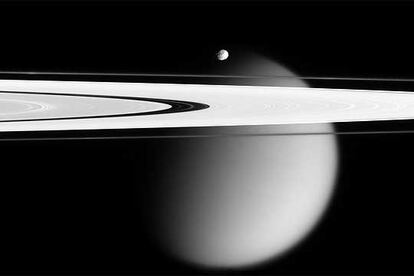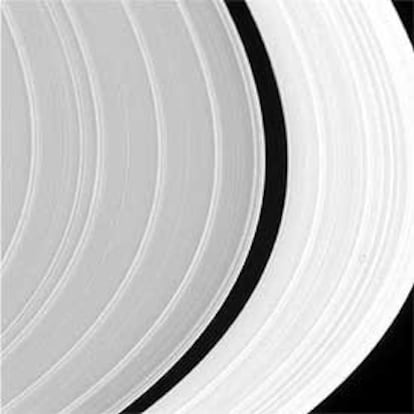How Saturn got its rings
The data the ‘Cassini’ probe gathered just before the mission ended help explain why the planet is surrounded by icy belts and why it tilts to the right

Approximately 160 million years ago, Chrysalis, one of the nearly 90 moons that orbit Saturn, destabilized, entered the giant planet’s field of gravity, and disintegrated. The remains of the lost moon formed Saturn’s rings. Chrysalis freed Saturn from the [gravitational] attraction of neighboring Neptune, with which it was synchronized, and gave Saturn the unique tilted orbit it has today.
Today, the journal Science published this novel explanation of the origin of Saturn’s rings for the first time. The hypothesis solves two mysteries simultaneously – Saturn’s unusual tilt and the age of the disks that surround that planet. The study’s principal investigator, Jack Wisdom, a physicist at the Massachusetts Institute of Technology (MIT), explains that his team simulated hundreds of scenarios using multiple variables until they obtained a result that fit the astronomical observations. “I don’t like catastrophes,” he says ironically, but the icy structures Saturn has now “can only mean that Chrysalis met a catastrophic end.”
The planetary sciences professor explains that the study’s “essential data” was collected by NASA’s Cassini probe just before the mission ended; in 2017, the spacecraft was intentionally plunged into
Saturn’s atmosphere and it disintegrated. The main question was where the planet’s mass is concentrated: “The planetary tilt depends on whether the matter is in the uniform core or on the surface, which would make Saturn behave in specific ways in each case,” Wisdom summarizes.
By comparing theoretical models with the spacecraft’s observations, the scientists discovered that Saturn was synchronized with Neptune at some point. The gravitational balance between the two planets was broken when Chrysalis disintegrated. That’s the astronomical equivalent of Saturn devouring its own child. The debris that now encircles the planet came from that process.
That’s why the researchers chose the name Chrysalis for Saturn’s lost moon. Similar to a butterfly’s metamorphosis, that moon “lay dormant for a long time, waiting for instability,” Wisdom says. When that time came, the moon shattered, forming Saturn’s rings. The study’s authors estimate that Chrysalis had a diameter of 1,500 kilometers, approximately half that of the Moon.

René Duffard, an astronomer at Andalucía’s Institute of Astrophysics who’s unaffiliated with the study, expresses his excitement about these important new findings. He notes that Wisdom’s team managed to “model many complex variables through simulations.” They’ve demonstrated their hypothesis of how Saturn’s icy structures formed, as well as why its rotation axis is tilted 26.7 degrees. As Duffard points out, the research also provides more information about Saturn’s largest moon, Titan, which moves about 13 centimeters further away from the planet each year. In turn, Titan helps explain Saturn’s tilt.
A specialist in asteroids, Duffard notes that the measurements are “very precise” and help piece together the curious history of how Saturn acquired its young rings. While the planet formed 4.5 billion years ago, the rings are only 160 million years old. In addition, he emphasizes that the study shows we should stop talking about gas giants and just call them giant [planets]. “Jupiter, Saturn, Uranus and Neptune are not [gas giant planets]. They have solid and liquid cores along with very large atmospheres, which is what was mistaken as gaseous,” the researcher explains. Jupiter and Saturn have solid cores up to four times larger than the Earth’s.
In the long term, Duffard believes that this analysis will be useful for studying exoplanets. Such investigations often use Saturn and Jupiter as references. “Just as a geologist studies the Earth’s surface and compares it to the Moon, we will be able to use this new information to study other worlds,” he avers. “We have discovered over 4,000 planets; the research possibilities are endless.”
Tu suscripción se está usando en otro dispositivo
¿Quieres añadir otro usuario a tu suscripción?
Si continúas leyendo en este dispositivo, no se podrá leer en el otro.
FlechaTu suscripción se está usando en otro dispositivo y solo puedes acceder a EL PAÍS desde un dispositivo a la vez.
Si quieres compartir tu cuenta, cambia tu suscripción a la modalidad Premium, así podrás añadir otro usuario. Cada uno accederá con su propia cuenta de email, lo que os permitirá personalizar vuestra experiencia en EL PAÍS.
¿Tienes una suscripción de empresa? Accede aquí para contratar más cuentas.
En el caso de no saber quién está usando tu cuenta, te recomendamos cambiar tu contraseña aquí.
Si decides continuar compartiendo tu cuenta, este mensaje se mostrará en tu dispositivo y en el de la otra persona que está usando tu cuenta de forma indefinida, afectando a tu experiencia de lectura. Puedes consultar aquí los términos y condiciones de la suscripción digital.










































